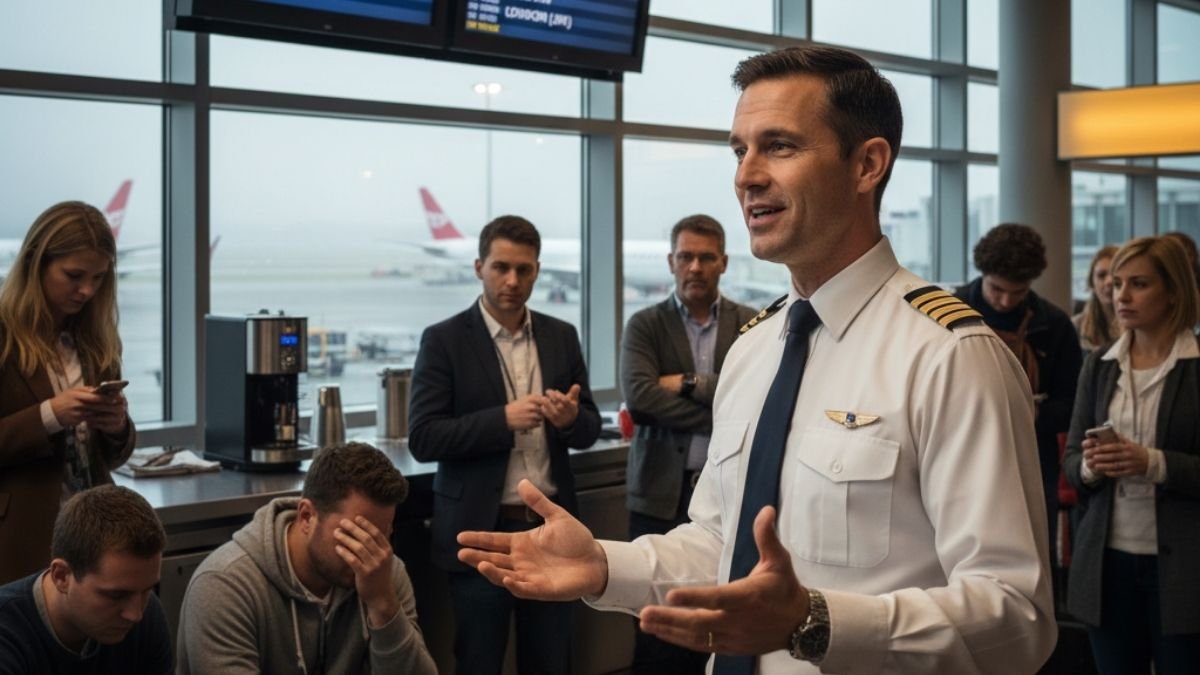
You know that 6 AM flight you’ve been avoiding like the plague? The one that requires a 4 AM alarm and makes you question all your life choices?
Yeah, that one.
Turns out, it might actually be your secret weapon for stress-free travel. But here’s where it gets interesting—pilots have some serious concerns about those early departures that nobody talks about.
I dove deep into aviation data, pilot forums, NASA studies, and insider perspectives to figure out what’s really going on. What I found surprised me. The truth about first flights isn’t what you think.
Bottom line upfront: Early morning flights are 30% less likely to get delayed and have an 80-90% on-time rate compared to 60-70% for afternoon flights. But they also come with hidden risks involving pilot fatigue, aircraft that sat out in freezing temps all night, and weather hazards that peak right at sunrise.
So should you book that crack-of-dawn departure or not?
Let’s get into it.
Why Airlines Are Obsessed With Their First Flights
⏰ The Domino Effect: How One Delay Ruins Everything
📈 Average Delay Accumulation by Flight Number:
Source: FAA Air Traffic Operations Network (OPSNET) analysis, 2023
Here’s something you might not know: airlines treat their first morning departure like it’s the most important flight of the entire day.
Why?
Because if they mess up that first flight, the whole day goes to hell.
Think about it like dominoes. When Flight 1 from Chicago to Denver leaves late, Flight 2 (which uses the same plane) now leaves late from Denver to Seattle. Then Flight 3 from Seattle to Portland is delayed. Then Flight 4… you get the idea.
The stats are wild: Morning flights before 9 AM achieve nearly 90% on-time departure rates. By late afternoon? That drops to 60-70%. And flights after 3 PM face a 50% higher cancellation risk compared to morning departures.
The Official Airline Guide puts it bluntly: “If an airline or airport can’t get the first wave of aircraft off on-time, they will be playing schedule catch-up for the rest of the day.”
But here’s the beautiful thing about first flights—they literally can’t be delayed by a previous flight. Because there is no previous flight. The plane sat at the gate overnight. No cascading delays. No crew members who’ve already been dealing with problems for six hours. No weather disruptions from earlier in the day.
It’s like starting a video game with a fresh save file instead of inheriting someone else’s disaster.
The Numbers Don’t Lie
Kathleen Bangs, a former commercial pilot who now works for FlightAware, breaks it down: “Roughly, you’ve got a 30% less chance of getting a long delay or cancellation if you go out in the morning.”
Thirty. Percent.
That’s not marginal—that’s massive.
And if your early flight does get messed up? You’ve got the entire day’s worth of flights available for rebooking. Try getting that same flexibility when your 8 PM flight gets canceled and the airport is shutting down for the night.
Airlines know this intimately. That’s why they send maintenance crews out hours before the flight crew arrives. They power up the aircraft using ground units to identify and fix issues while there’s still time. Because discovering a maintenance problem at 6 AM with a 6:30 departure is exactly the nightmare scenario they’re trying to avoid.
But Here’s What Pilots Know (That You Don’t)
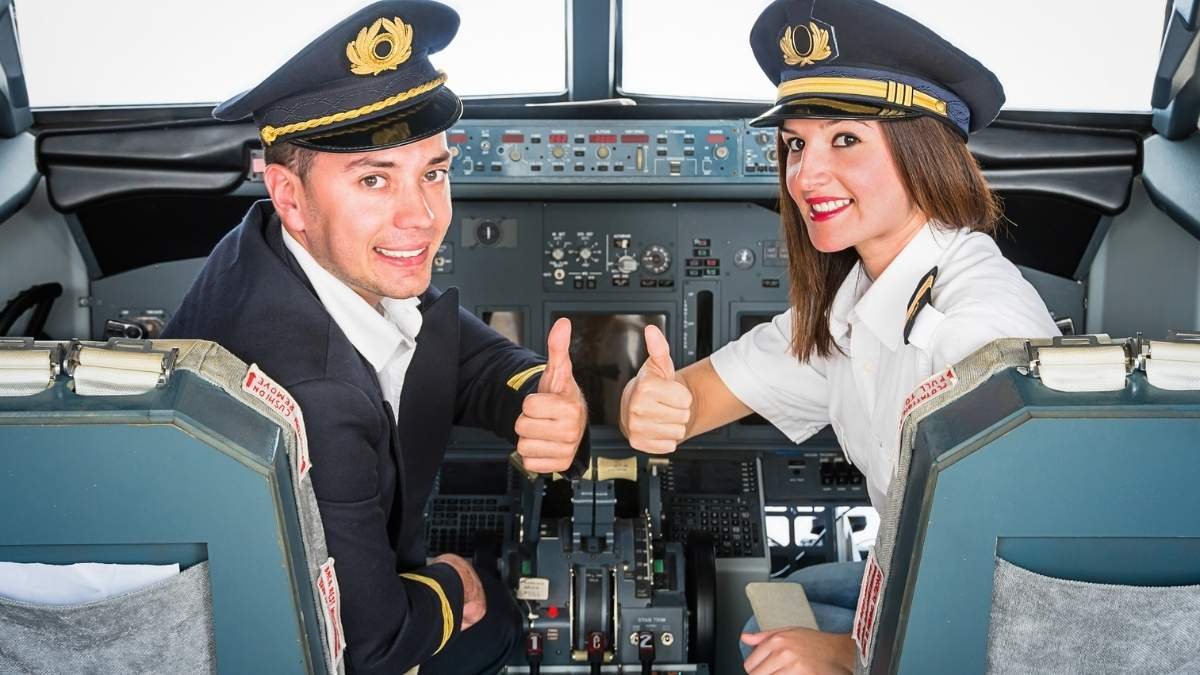
Okay, so first flights sound amazing, right? Lower delays, cleaner planes, better rebooking options.
Hold on. We need to talk about what’s happening on the other side of that cockpit door.
Remember, while you’re grumbling about your 4 AM wake-up, your pilot probably woke up at 3:30 AM. And they didn’t sleep great either.
The Scary Science of Sleep-Deprived Pilots
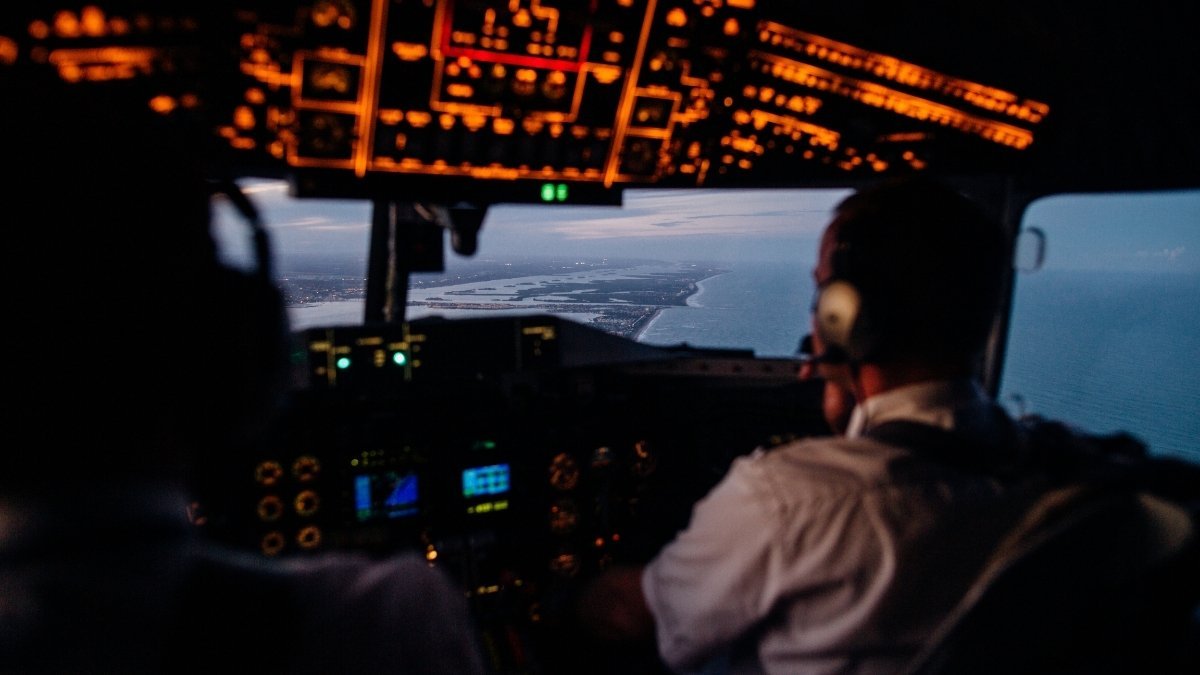
A NASA study tracked 95 airline pilots through 1,476 flight duty periods. What they found should make you think twice about that 6 AM departure.
Pilots operating early morning flights (starting between 5:00 and 6:59 AM) got an average of just 6.90 hours of sleep the night before. That’s below the recommended 7-8 hours for, you know, safely operating a 175,000-pound metal tube at 500 mph.
Even worse? Their reaction times at the start of their shift were significantly slower than those of pilots working later flights.
The researchers found that pilots lose approximately 15 minutes of sleep for every hour their duty starts before 9:00 AM. Do the math on a 5 AM report time—they’re waking up around 4:19 AM after inadequate sleep.
And here’s the kicker: your pilot’s body temperature is at its absolute lowest between 2-6 AM. That’s when sleep pressure is highest and alertness is, well, not great. U.S. Air Force studies found that over 50% of fatigue-related mishaps occurred between 1:00 and 7:00 AM.
The Most Disturbing Story You’ll Read Today

A Miami-based cargo pilot shared his experience on a fatigue awareness site. After multiple consecutive 4:30 AM check-ins, he woke up in the cockpit to find his first officer also sleeping.
Both pilots. Asleep. On an international flight.
“After more than two hours, I woke up and looked at my watch. What happened? Why didn’t the first officer wake me up? I hurried into the cockpit. The first thing I saw when I looked out the front windshield were a lot of lights on the ground below.”
Now, this was a cargo operation (different rules, potentially longer duty periods), but it illustrates the end of what early-start fatigue can do.
The NASA study actually identified the sweet spot: 7:00-10:59 AM departures. Late enough that pilots get decent sleep, early enough to avoid the accumulated exhaustion of late finishes.
So if you’re looking for the perfect balance of on-time performance AND a well-rested crew? That 8 AM flight might be your goldilocks zone.
What Happens to Your Plane While You Sleep
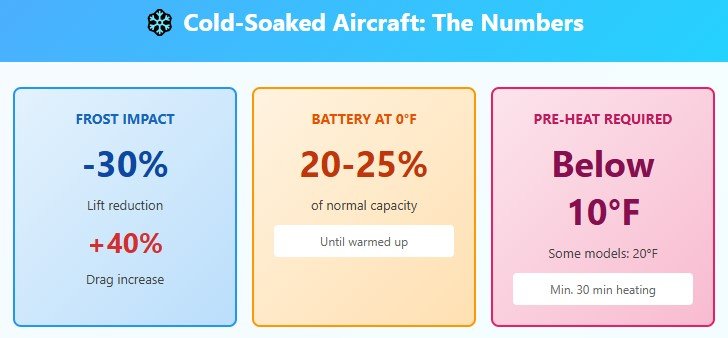
While we’re talking about things you don’t think about—let’s discuss what happened to your aircraft overnight.
It’s been sitting out there since 9 PM yesterday. Depending on where you are, that plane has been soaking in the cold (or heat) for 9+ hours. Aviation folks call this being “cold-soaked.”
And cold-soaked aircraft can be problematic.
When Frost Becomes a Five-Letter Word
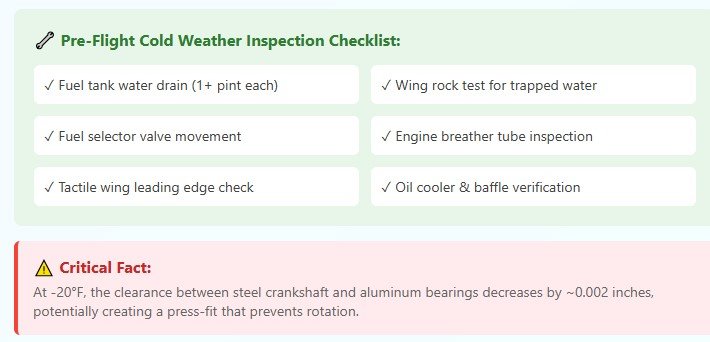
Here’s something that sounds crazy but is completely true: even a barely visible layer of frost can reduce an aircraft’s lift by up to 30% and increase drag by 40%.
That’s catastrophic. That’s “we’re not getting airborne” levels of bad.
The NTSB has documented multiple fatal accidents where inadequate frost removal led to crashes shortly after departure. We’re not talking about a thick coating—sometimes it’s so thin you can barely see it, appearing as just a light dusting on the wings.
The really insidious part? “Clear ice” on cold-soaked wings. If your plane flew at 35,000 feet last night, the fuel in the wing tanks might still be at -20°C or colder the next morning. Even when the outside air is a comfortable 59°F, moisture can condense and freeze on those supercooled wings.
Pilots can’t just eyeball it. They have to physically run their hands along the wing’s leading edges to detect virtually invisible ice.
The Pre-Flight Inspection That Takes Forever

Before the first flight can leave, pilots have to do a much more extensive inspection than the quick walkaround between daytime flights.
They need to:
- Drain at least a pint from each fuel tank’s sump to check for water contamination
- Rock the wings to dislodge trapped water before sampling
- Check fuel selector valves (which can freeze overnight)
- Inspect engine breather tubes for frozen moisture
- Verify oil coolers, crankcase, and baffles
In freezing temperatures, aircraft engines need pre-heating for at least 30 minutes before start. At -20°F, the clearance between a steel crankshaft and aluminum bearings shrinks by about 2 thousandths of an inch—enough to potentially prevent proper rotation.
Oh, and battery capacity? At 0°F, it drops to just 20-25% of normal until warmed up.
All of this explains why your 6 AM departure sometimes doesn’t push back until 6:40 AM, even though the plane was just sitting there.
The Weather Pattern Nobody Warns You About
🌫️ Weather Threats: Morning vs Afternoon
Morning Fog
Afternoon Storms
📊 Radiation Fog Formation Timeline:
Source: NTSB accident data 2008-2022 & FAA OPSNET 2017-2023
Pop quiz: What’s more dangerous for aviation—spectacular afternoon thunderstorms or quiet morning fog?
If you said thunderstorms, you’re thinking like a nervous passenger. Pilots? They’ll take thunderstorms any day.
Why Fog is Actually the Villain
Thunderstorms are dramatic. They show up on radar as angry red blobs. Air traffic control can route around them. Pilots can see them coming. And critically, they’re localized. An airport 50 miles away might be clear.
Morning fog? That’s a different beast entirely.
Radiation fog forms through a simple but relentless process. On clear nights with light winds, the ground loses heat to space. As the surface cools, it chills the air directly above it. When the temperature drops to within 5°F of the dew point, moisture condenses into fog.
The process intensifies through the night, reaching maximum density right at sunrise.
Right when your first flight is supposed to leave.
Unlike afternoon thunderstorms that pilots can see and avoid, fog blankets entire airports with no escape route. The FAA implements Low Visibility Procedures when visibility drops below 2,000 feet. When fog is particularly thick, it can prevent the sun’s heat from even reaching the surface, creating persistent conditions that last for hours.
Here’s the stat that matters: Low ceilings and visibility accounted for 58% of weather-related accidents between 2008 and 2022. Not thunderstorms. Not ice. Visibility.
The Inversion Nobody Talks About
Temperature inversions that form overnight create their own special hell. These stable atmospheric layers trap fog, pollutants, and haze near the surface.
While passengers appreciate the glass-smooth air, pilots are dealing with non-convective low-level wind shear—a treacherous condition where surface winds sit calm while winds at 2,000 feet can exceed 50 knots. Suddenly climbing through that layer, the airplane experiences airspeed and lift changes despite zero turbulence.
And here’s something wild: jet blast from your takeoff can actually stir fog across the field, causing it to form or intensify in areas that were clear, potentially trapping the flights behind you.
The silver lining? Morning fog is usually predictable and temporary. When it’s not present, you launch with near-perfect reliability. When it is present, you typically wait 1-2 hours for the sun to burn it off.
Afternoon thunderstorms offer no such predictability. They can persist for hours across multiple states and create cascading delays throughout the entire national airspace system.
What Pilots Really Say When Nobody’s Listening
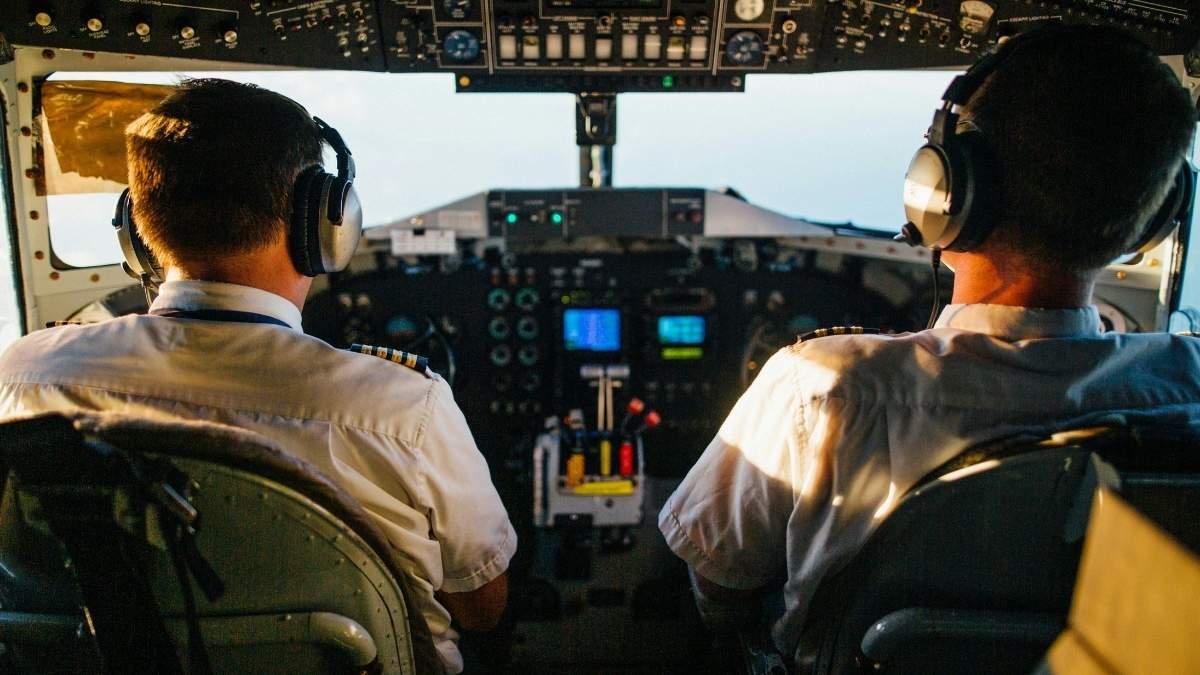
Professional pilot forums are… enlightening. These folks don’t sugar-coat things.
On PPRuNe (Professional Pilots Rumour Network), the world’s largest aviation discussion board, you’ll find threads about early morning operations that all hit the same themes.
“On the whole, morning flights induce more fatigue than afternoon flights,” notes one post synthesizing European Aviation Safety Agency research. The recommendation? “Limit the number of successive morning rosters (maximum two days)” and “Avoid short nights off that finish late and start early.”
These aren’t casual suggestions. They’re fatigue risk management protocols.
The Rituals Pilots Use to Cope
Pilots have developed elaborate preparation rituals just to handle early starts.
“If I do have a very early start planned for the next morning, I do shower and shave the evening before I go to bed, so I do not need to waste time with this in the morning,” one pilot wrote. “Helps to reduce stress/worries.”
Think about that. Professional aviators are optimizing their evening routine just to steal an extra 15 minutes of sleep before a 4 AM wake-up.
SKYbrary’s expert analysis is blunt: “Most pilots are not able to compensate for early wake-ups by falling asleep earlier. Instead, they usually lose about one hour of sleep.”
This isn’t a willpower issue—it’s biology. There’s something called the “evening wake maintenance zone,” a period in the few hours before typical bedtime when your body actively resists sleep. Ask a pilot to go to bed at 8 PM for a 4 AM wake-up, and their circadian system fights them.
But They Also Acknowledge the Upsides

From Simple Flying’s pilot perspective: “Flying before dawn usually means there are fewer planes in the air since early mornings aren’t the most popular departure time. Pilots contend with fewer planes during their taxi out to the runway and are more likely to get direct clearances from controllers.”
One pilot described it poetically: “Watching the sun rise above the eastern horizon at 30,000 feet is a special treat. What starts as a hint of light on the edge of the Earth quickly turns to an amber burn, followed by the colors of fire in the sky.”
And from Tim, a flight attendant who worked for major carriers: “I’d say 95% of flights in the morning will leave on time. The crew will be fresh from a good night’s sleep, and mentally unencumbered by a hard day’s work attending to every whim of hundreds of travelers.”
He continued: “Some of the big short-haul airlines expect crew to fly up to six legs in a single shift—that is a long day.”
The Surprising Case FOR First Flights (Despite Everything)
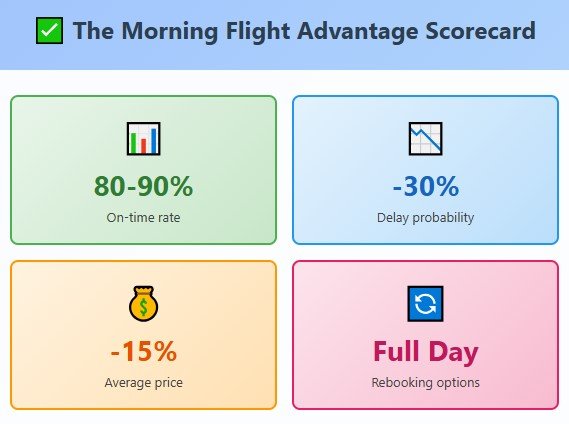
Okay, so we’ve covered pilot fatigue, cold-soaked aircraft, frost dangers, radiation fog, and temperature inversions.
And yet…
The unanimous verdict from aviation professionals is: book the first flight.
I know. Wild, right?
The Government Actually Recommends It
The U.S. Department of Transportation—in their official “Fly Rights” consumer guidance—states it directly: “A departure early in the day is less likely to be delayed than a later flight, due to ‘ripple’ effects of delays throughout the day.”
This isn’t marketing spin. This is federal consumer advice based on decades of operational data.
Bureau of Transportation Statistics data shows that first flights achieve a 10+ percentage point advantage in punctuality. At airports like Boston and Las Vegas, nearly 90% of early morning flights departed on time, while fewer than 50% left punctually by nightfall at the same facilities.
That’s not a marginal improvement. That’s the difference between showing up for your meeting on time and scrambling to apologize via phone.

The Hidden Benefits Nobody Talks About
Your plane is actually clean. Airlines do deep overnight cleaning that’s impossible during the day’s rapid turnarounds. Tim explained: “When I worked on one of Europe’s biggest budget operators, we sometimes had a 25-minute turnaround to make the entire plane ready for the next flight.”
Twenty-five minutes. To check for belongings, clean and disinfect the cabin, verify safety cards in every seatback, and confirm life jackets under seats.
“Taking the first flight of the day means you won’t have to deal with an aircraft that’s been used to carry hundreds (or thousands) of passengers yet.”
Fewer planes means faster everything. Less air traffic congestion means controllers can approve more efficient routings, saving time and fuel while reducing delays from flow restrictions. You’re not waiting in a 15-plane takeoff queue.
The crew freshness debate cuts both ways. Yes, early pilots got less sleep. But the alternative is crew members near the end of 10-12 hour duty periods. “How you feel when your work day is first getting started, and how you feel when it’s winding down,” suggests FareCompare.
If weather or mechanical issues delay an evening flight, crews may “time out” entirely under FAA duty hour regulations—forcing cancellation. Morning crews have their full duty day available to work through problems.
Follow the Money (and the Experts)
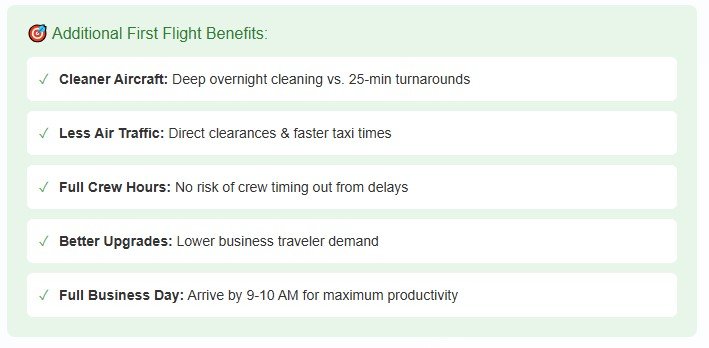
First flights run about 15% cheaper on average. Long-haul international flights show $959.87 average fares for 4-8 AM departures versus $1,102.88 for 8-10 PM flights.
And here’s the tell: aviation professionals who understand these tradeoffs intimately—pilots, air traffic controllers, travel industry executives—consistently choose early departures for their own travel.
Their revealed preferences speak louder than any statistics.
When the Morning Advantage Completely Backfires
⚠️ When to AVOID First Flights
🚫 Personal Risk Factors:
Sleep disruption may outweigh benefits
4 AM wake compounds sleep issues
Pre-dawn logistics can be nightmarish
Increased fall risk in dark airports
The superiority of first flights comes with asterisks. Certain conditions flip the script entirely.
The Situations Where You Should Absolutely Avoid Early Flights
Overnight winter storms create the worst scenario. Your aircraft is covered in snow and ice requiring extensive ground de-icing. What looked like a 6 AM departure becomes 8:30 AM once you finally get to the front of the de-icing queue—and that’s if you’re lucky.
Persistent radiation fog doesn’t always burn off on schedule. Forecasters may predict clearing by 8 AM, but conditions persist past noon. Valley airports in California, the Pacific Northwest, and Appalachia are particularly susceptible.
Maintenance issues discovered overnight eliminate the first flight’s “no cascading delay” advantage. If mechanics find a problem requiring parts, your 6 AM departure has nowhere to hide. Airlines with large fleets can sometimes substitute aircraft, but smaller carriers often lack this flexibility.
Very early departures before 6 AM push pilot fatigue into dangerous territory. Pilots reporting at 4:30 AM likely woke at 3:30 AM or earlier after sleeping 5-6 hours. At this extreme, the “fresh crew” advantage disappears.
Airport services are limited. Rental car counters, restaurants, retail shops, and even some airline customer service desks don’t open until 6-7 AM. Public transit may not be operating. Ride-share surge pricing kicks in. Parking lots are darker and less secure.
Personal Factors That Trump Statistics
If you’re not a morning person, chronically have insomnia, are traveling with young children, or are elderly, the sleep disruption might outweigh any on-time performance benefit.
There’s no point in catching a reliable flight if you’re too exhausted to function at your destination.
The Behind-the-Scenes Operations You Never See

Morning aviation operations follow protocols that afternoon crews never experience. These procedures, largely invisible to passengers, explain both the reliability and the vulnerabilities of first flights.
What Happens at 4 AM at the Airport
FOD walks sweep runways before first operations. Ground crews walk the entire runway surface in lines, looking for any debris that could damage engines or tires. This daily pre-dawn safety ritual costs time but prevents catastrophic incidents.
ATC shift changes typically occur around 6 AM. The morning shift change requires extensive briefings as overnight controllers hand off active traffic, weather patterns, and any special operations to incoming day shift personnel. During this transition, throughput may temporarily decrease.
Aircraft positioning flights often occur overnight—empty aircraft flying from maintenance bases to high-demand hubs. Your 6 AM Chicago to Denver flight might be operated by an aircraft that flew empty from Omaha at 4:30 AM. If that positioning flight encounters issues, your scheduled aircraft doesn’t arrive.
Ramp agents and baggage handlers start shifts as early as 3:30-4:00 AM, working in darkness and often freezing temperatures. They’re operating tugs, belt loaders, and aircraft stairs under the same fatigue pressures affecting pilots.
TSA screening ramps up around 4:00-4:30 AM, though at some airports, certain checkpoints may not open until 5-6 AM, creating bottlenecks.
The compressed timeline is unforgiving. Ground crews must service an aircraft in 45-60 minutes with the added complexity of overnight issues: thicker engine oil requiring longer warm-up, hydraulic fluid responding sluggishly in cold, and de-icing operations that didn’t exist for yesterday’s arrival.
What the Accident Data Actually Reveals
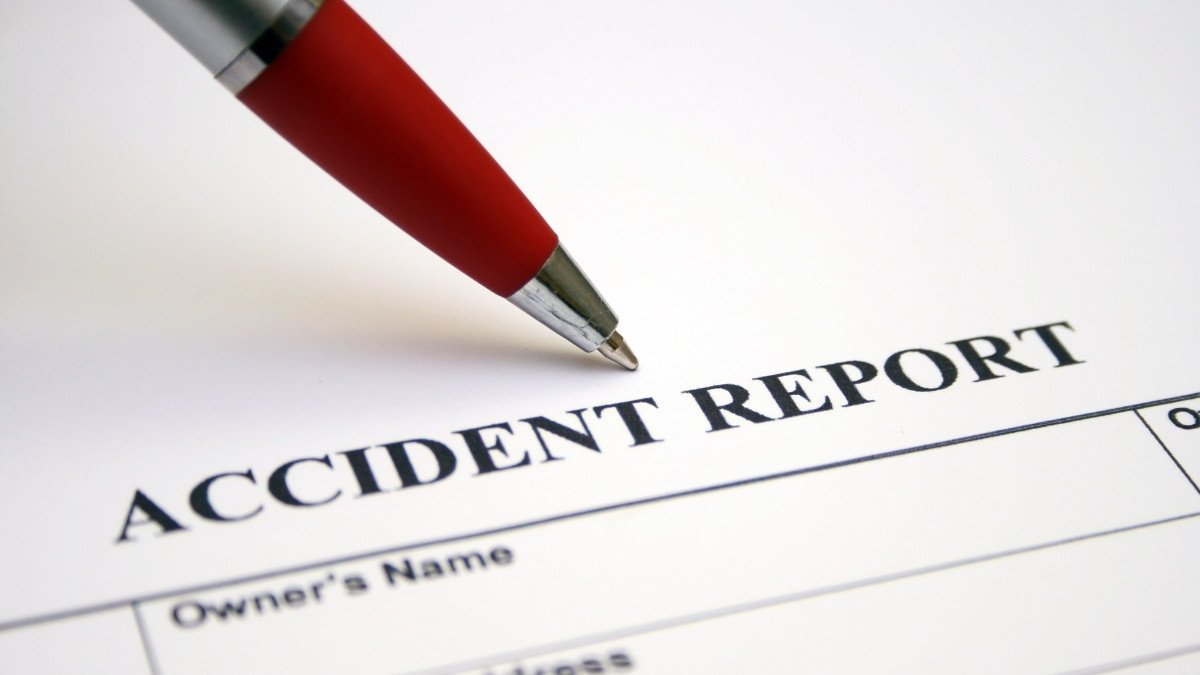
Let’s address the elephant in the room: are first flights more dangerous?
Modern commercial aviation has achieved extraordinary safety. The all-accident rate was 1.13 per million flights in 2024—roughly one accident per 880,000 flights. Fatal accidents? Approximately one per 16 million flights globally.
U.S. major carriers operated in 2023 with zero onboard fatalities for the eighth consecutive year.
Time of Day Isn’t a Primary Accident Factor
Here’s what’s interesting: time of day is not tracked as a primary causal factor in commercial aviation accident databases maintained by NTSB, FAA, ICAO, Boeing, or Airbus.
Phases of flight appear (takeoff, cruise, approach, landing), as do pilot error (53% of accidents), mechanical failure (21%), and weather (11%). But “first flight vs. later flight” isn’t a significant accident classification category.
This absence is itself meaningful. If first flights demonstrated elevated accident rates, safety investigators would have identified the pattern decades ago.
However, fatigue does appear as a contributing factor in specific accidents. Research found 23% of major aviation accidents between 2001 and 2012 attributed fatigue as a contributing factor. Military aviation data shows that over 50% of Air Force fatigue-related mishaps occurred between 1:00 and 7:00 AM.
But commercial aviation’s safety systems appear adequate to manage these risks, evidenced by the stellar safety record.
The statistical: First flights aren’t inherently dangerous in commercial operations, but they require enhanced vigilance around fatigue management, weather assessment, and aircraft preparation.
Your Action Plan: How to Actually Use This Information
Alright, you’ve made it through all the data, the scary pilot stories, the weather patterns, and the operational complexity.
So what do you actually do with this information?
The Goldilocks Strategy
Target flights departing 7:30-9:30 AM if possible. You still capture most of the “first flight advantage”—fresh aircraft, minimal cascading delays, stable weather—while avoiding the physiological challenges of 5-6 AM departures.
This window gives pilots adequate sleep while keeping them in the high-reliability zone.
Before You Book
Monitor weather patterns for your departure day. If winter fog is forecast, your first flight advantage evaporates. A 9 AM departure becomes smarter. If afternoon thunderstorms are predicted, the early departure becomes more valuable.
Book the most direct routing possible. The on-time performance advantage compounds. A 90% reliable first flight connecting to an 85% reliable second flight gives you a 76.5% probability that both work. Two later flights at 70% each? Your combined probability drops to 49%.
Check what “first flight” actually means. A 7 AM departure might be the airline’s first service to your destination, even if a competitor offers 5:45 AM, giving you operational advantages without the extreme wake-up.
The Night Before
Prepare like a pilot: Shower, pack carry-on, lay out clothes, load electronics, prep coffee maker. Every minute eliminated from your morning routine equals additional sleep.
Don’t just go to bed early—that rarely works. Consider waking up at your required time (say 4 AM) for two days before your flight to shift your body clock.
Morning of Departure
Allow more time than normal. If you typically arrive 90 minutes early, make it two hours for a 6 AM departure to account for closed TSA checkpoints, limited airport access roads, and your own grogginess.
Have backup flights identified before departure. If your 6 AM gets canceled, you want to immediately request the 10:30 AM, not stand in line for 45 minutes while that flight fills up.
At Your Destination
Verify arrival logistics. If you’re landing at 8 AM, confirm rental car counters are open, your hotel allows early check-in, or business contacts are available. The operational benefits disappear if you’re sitting in a closed hotel lobby until 3 PM.
The Final Verdict from 30,000 Feet
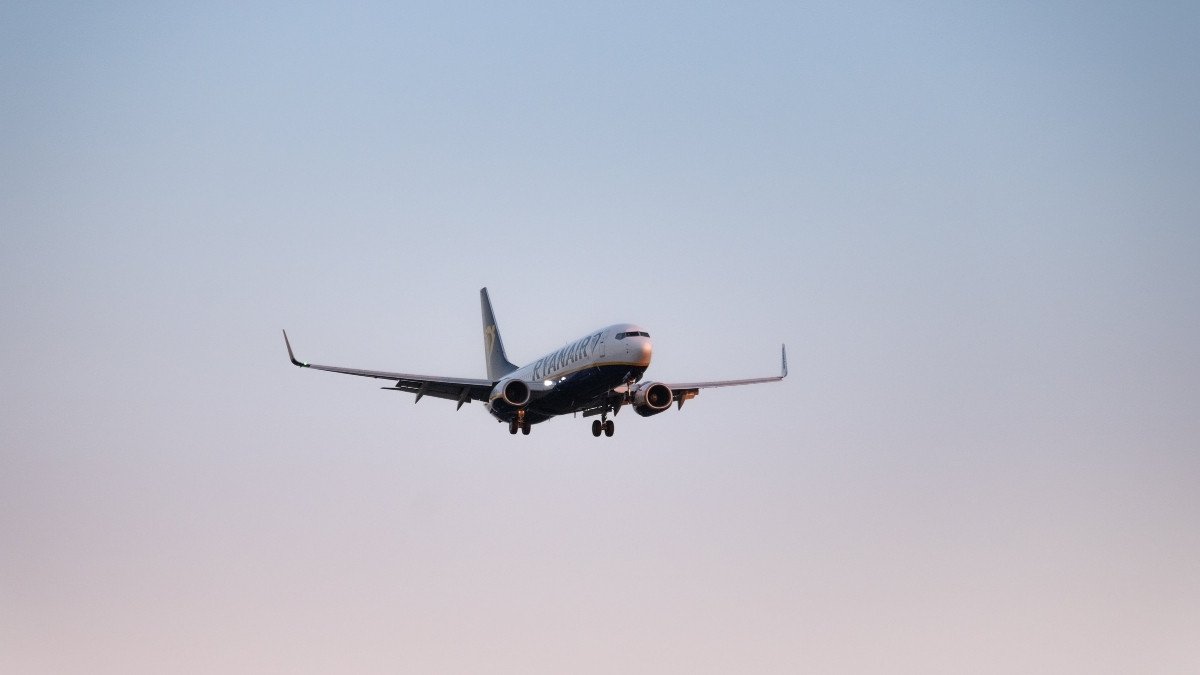
After examining operational statistics, pilot fatigue research, weather patterns, maintenance procedures, and accident data, here’s my take:
First flights offer substantial practical advantages that outweigh their challenges for most travelers.
The 30% reduction in delay probability isn’t marginal—it’s massive. The 80-90% on-time performance versus 60-70% for afternoon flights is the difference between reliable and unreliable travel.
But these advantages come with real caveats. Pilot sleep deprivation is measurable and significant. Cold-soaked aircraft challenges are real. Radiation fog can eliminate the advantage entirely at susceptible airports.
My Personal Recommendation
For maximum reliability + crew wellness: Book flights in the 7:00-10:00 AM window.
For absolute maximum on-time performance (and you can handle the wake-up): Book the first departure (usually 5:30-6:30 AM).
For personal comfort while still seeking reliability: Aim for 8-9 AM departures.
If you’re booking after noon, Expect delays to increase proportionally to departure time. Afternoon and evening flights enter genuinely unreliable territory.
The Tell-Tale Sign
The U.S. Department of Transportation’s official guidance: “A departure early in the day is less likely to be delayed.”
Pilots grumble about pre-dawn wake-ups but choose early flights for their own travel.
Airlines obsess over first flight punctuality because it determines whether their entire day succeeds or descends into cascading failure.
For passengers, that industry obsession translates directly into better travel experiences—if you can set that 4 AM alarm.
Now it’s your turn: What’s your take on early morning flights? Are you team “6 AM departure” or team “I’d rather walk”? Drop your horror stories (or success stories) in the comments below.
And if this article helped you make a smarter booking decision—or at least understand why your pilot looked exhausted at 5:30 AM—share it with your fellow travelers. They’ll thank you when they’re not sleeping on airport benches because their evening flight got canceled.
Safe travels, friend. And maybe set that alarm a little earlier next time.






